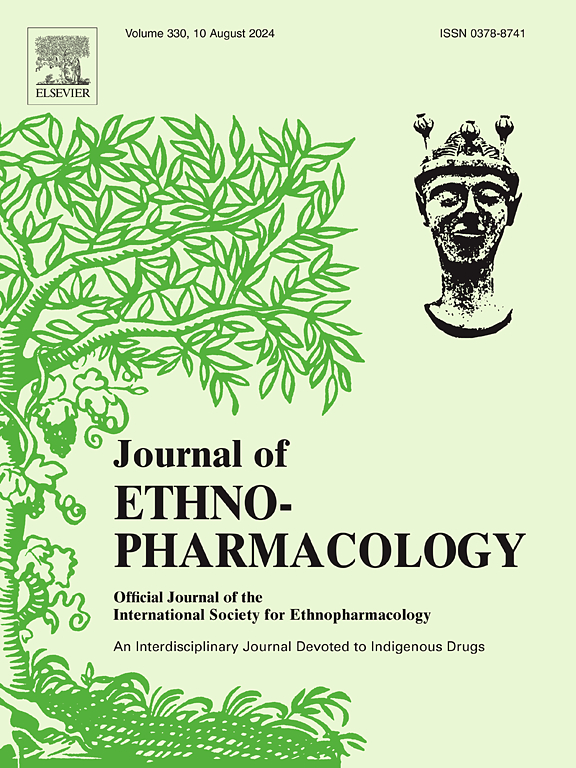综合代谢组学和网络药理学揭示雪碧抗脓毒症所致心肌功能障碍的机制
IF 4.8
2区 医学
Q1 CHEMISTRY, MEDICINAL
引用次数: 0
摘要
本文章由计算机程序翻译,如有差异,请以英文原文为准。

Integrated metabolomics and network pharmacology reveal the mechanisms of Xuebijing in counteracting sepsis-induced myocardial dysfunction
Ethnopharmacological relevance
Xuebijing (XBJ) injection is a Traditional Chinese medicine (TCM) injection extracted and prepared using modern TCM formulation techniques. As a widely used treatment for critically ill patients, XBJ injection has shown significant therapeutic effects in clinical applications in China. It plays an indispensable role in sepsis-induced myocardial dysfunction (SIMD). However, its underlying mechanisms require further investigation.
Objective
This study aims to investigate the cardioprotective effects of XBJ in sepsis and to elucidate its underlying mechanisms.
Methods
Network pharmacology was used to predict the potential active components and core targets of XBJ against SIMD. Furthermore, animal models were used to verify its pharmacodynamics. Metabolomics was integrated to track the myocardial tissue metabolites from septic rats. Molecular docking, qRT-PCR, Western blot, and immunofluorescence were performed to investigate the mechanisms of action.
Results
Network pharmacology predicted that the efficacy of XBJ is attributed to 104 active components and 178 targets. Metabolomics of myocardial tissue from CLP rats revealed that the key metabolic pathways included the tricarboxylic acid (TCA) cycle, pyrimidine metabolism, and purine metabolism. Five core active components of XBJ (quercetin, luteolin, rutin, β-sitosterol, and cryptotanshinone) can modulate interleukin-6 (IL-6), epidermal growth factor receptor (EGFR), B-cell lymphoma 2 (BCL2), peroxisome proliferator-activated receptor gamma coactivator 1-alpha (PGC-1α), and hypoxia-inducible factor 1-alpha (HIF-1α). Molecular docking analysis confirmed that the core components of XBJ have a strong affinity for these key targets. Additionally, qRT-PCR, Western blotting, and immunofluorescence results indicated that XBJ can reverse the expression of these targets, ameliorated energy metabolism dysregulation, and alleviated SIMD.
Conclusion
XBJ exerts protective effects in a rat model of sepsis-induced myocardial injury, by modulating energy metabolism pathways that regulate key SIMD-related targets (IL-6, EGFR, BCL2, PGC-1α, and HIF-1α), thereby improving myocardial energy metabolism and alleviating inflammatory responses.
求助全文
通过发布文献求助,成功后即可免费获取论文全文。
去求助
来源期刊

Journal of ethnopharmacology
医学-全科医学与补充医学
CiteScore
10.30
自引率
5.60%
发文量
967
审稿时长
77 days
期刊介绍:
The Journal of Ethnopharmacology is dedicated to the exchange of information and understandings about people''s use of plants, fungi, animals, microorganisms and minerals and their biological and pharmacological effects based on the principles established through international conventions. Early people confronted with illness and disease, discovered a wealth of useful therapeutic agents in the plant and animal kingdoms. The empirical knowledge of these medicinal substances and their toxic potential was passed on by oral tradition and sometimes recorded in herbals and other texts on materia medica. Many valuable drugs of today (e.g., atropine, ephedrine, tubocurarine, digoxin, reserpine) came into use through the study of indigenous remedies. Chemists continue to use plant-derived drugs (e.g., morphine, taxol, physostigmine, quinidine, emetine) as prototypes in their attempts to develop more effective and less toxic medicinals.
 求助内容:
求助内容: 应助结果提醒方式:
应助结果提醒方式:


